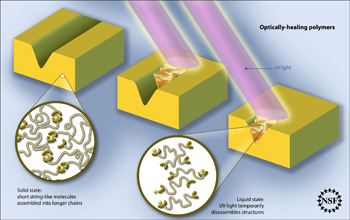Researchers from Case Western Reserve University and from the University of Fribourg have developed a new substance that can heal itself of scratches when exposed to UV light.
The material in question is called a ‘metallo-supramolecular polymer’. A polymer is simply a long chain of smaller molecules. For example, a protein is a polymer of amino acids. In this case, the smaller molecules, which can vary depending on needs, are attached to one another via metal ions. Upon exposure to UV light, the metal ions absorb the light energy and heat up, in effect ungluing the polymer chain at that site. The components of the polymer are temporarily free to flow together, eliminating cracks or flaws along the way. As soon as the light is switched off, the material re-solidifies without the defects.

Schematic of optically healing polymers. The specially designed polymer molecules that make up the solid item can be disassembled by the UV light so that they flow and fill in the cracks. When the light is turned off, the molecules reassemble themselves and the filled cracks become rigid again.
The whole process takes only seconds and can be repeated over and over without compromising the integrity of the substance. Although only in the proof of concept stage, the researchers are confident that these materials will soon find widespread use.
As team leader Stuart Rowan says:
One of our next steps is to use the concepts we have shown here to design a coating that would be more applicable in an industrial setting.
No comments:
Post a Comment